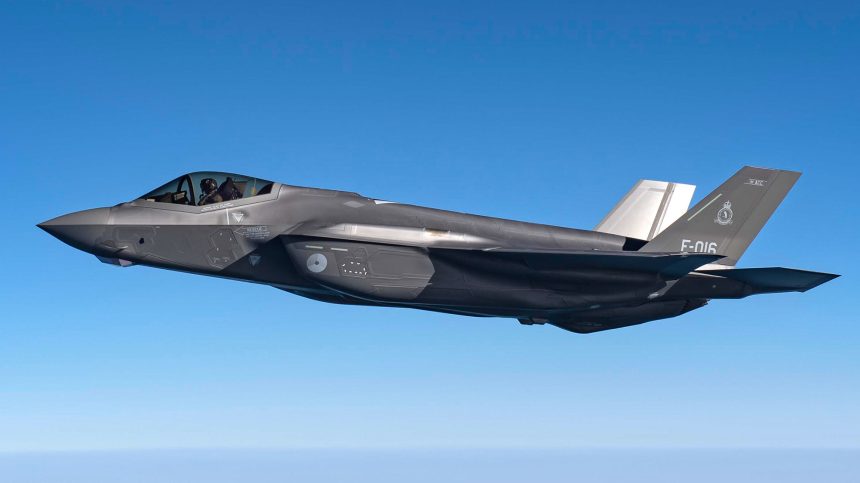The Royal Netherlands Air Force (RNLAF) achieved a first-of-its-kind milestone during the Ramstein Flag Multi-Domain Operations (MDO) exercise.
In what is considered “a significant step forward in multi-domain integration,” the Royal Netherlands Air Force (RNLAF) and Lockheed Martin’s Skunk Works successfully demonstrated the first-ever live classified data exchange between an in-flight F-35 and a non-U.S. Command and Control (C2) system. The test took place during Ramstein Flag, a major multinational live-fly exercise that began on March 31 and concluded on April 11, 2025.
During the exercise, Dutch F-35s operating in an Anti-Access Area Denial (A2AD) environment detected and identified multiple simulated ground targets. Utilizing the Multifunction Advanced Datalink (MADL), the targeting data was transmitted through Skunk Works’ Open Systems Gateway (OSG) into Keystone, the Dutch C2 environment. Keystone then relayed the information to a rocket artillery platform, which engaged and neutralized the target, completing the kill chain within minutes.
Gisteren is er tijdens Ramstein Flag @VlbLeeuwarden een belangrijke stap gezet in het multi domein-optreden.
F-35’s en het Nederlandse commandosysteem Keystone wisselden namelijk voor het eerst buiten de Verenigde Staten live gegevens uit.
Lees meer 👇 https://t.co/CDwxeBHicB
— Koninklijke Luchtmacht (@Kon_Luchtmacht) April 9, 2025
This achievement underscores the F-35’s capability to integrate seamlessly with allied C2 systems, enhancing joint operational effectiveness. By unlocking the vast data generated by the F-35, the OSG enables allied air and missile defense systems to receive precise targeting information, improving threat detection and response times.
Air Commodore Bert ‘Vida’ de Smit of the RNLAF remarked:
“Ramstein Flag was a resounding success, demonstrating the power of collaboration between United States Air Forces in Europe – Air Forces Africa (USAFE-AFAFRICA) and Skunk Works. We are thrilled with the results and look forward to continuing this work with our partners to drive innovation and advance our integrated battlespace capabilities.”
OJ Sanchez, Vice President and General Manager of Lockheed Martin Skunk Works, added:
“The combined joint all-domain capabilities demonstrated at Ramstein Flag are a breakthrough in multi-domain operations, emphasizing the F-35’s ability to seamlessly integrate with our international partners’ C2 environments. This achievement is a testament to the strength of our partnerships with the RNLAF and USAFE-AFAFRICA. Lockheed Martin is accelerating delivery of novel MDO capabilities that enhance the effectiveness of our allies’ F-35 fleets to ensure peace through allied strength.”
This is certainly not the first time a fifth-generation aircraft has been used to shorten what’s known as the sensor-to-shooter cycle — the critical window of time between detecting a target and delivering weapons on it. In high-tempo, highly dynamic battlefields, shaving seconds off that timeline can be decisive. The goal is clear: fuse data, share it fast, and shoot first.
As early as 2016, the U.S. Marine Corps explored the F-35’s role in networked kill chains. In a live-fire demonstration, an F-35B from VMX-1 at Edwards Air Force Base integrated into the Naval Integrated Fire Control–Counter Air (NIFC-CA) architecture. Acting as a forward sensor, the jet detected an over-the-horizon cruise missile threat and pushed the targeting data via Multifunction Advanced Datalink (MADL) to a ground station linked to USS Desert Ship (LLS-1) — a land-based Aegis system simulator. The simulated ship, equipped with Aegis Baseline 9.C1 and a Standard Missile 6, successfully engaged and destroyed the target. It was a pivotal moment, showing how a stealth fighter could extend the sensor reach of naval air defense.
In 2018, an F-35B shared target data with a HIMARS (High Mobility Artillery Rocket System), further validating the jet’s ability to cue land-based fires in near real time. These tests confirmed what many in the community had long suspected: fifth-gen fighters are not just shooters, but multi-domain sensors, capable of feeding targeting data to ground, sea, or air platforms.
Even before the F-35, the F-22 Raptor had begun to redefine how a fighter contributes to the broader mission. Back in 2013, then PACAF commander Gen. Hawk Carlisle described how the Raptor could use its advanced sensors to provide targeting data for submarine-launched Tomahawk Land Attack Missiles (TLAMs). In Operation Inherent Resolve, the F-22’s role evolved into what was described as “kinetic situational awareness.” Raptors escorted strike packages in and out of Syrian and Iraqi airspace, using their AESA radar and sensor fusion to build a detailed picture of the battlespace. That intelligence was then shared with other assets — from attack jets to airborne early warning platforms — improving the overall situational awareness of the entire strike force.
The F-35 inherits this mission, and takes it further. With MADL, EOTS (Electro-Optical Targeting System), AN/AAQ-37 Distributed Aperture System (DAS), and its integrated fusion engine, the jet is designed to be a real-time battlespace quarterback, orchestrating fires and data across domains. Whether feeding targeting data to a ship, cueing ground-based interceptors, or supporting long-range fires from another continent, the fifth-generation fighter is no longer just a trigger puller — it’s the first node in the kill chain.
And now, thanks to efforts like the Dutch integration with Keystone, that kill chain no longer stops at U.S. borders.
The news of the groundbreaking test comes in the wake of the controversy about the potential U.S. limitations on foreign-operated F-35s and the supposed existence of a “kill switch”.
As we explained in detail in a previous article about the “kill switch” myth, according to which the U.S. government has the ability to remotely disable or limit the operational capabilities of foreign-operated F-35 fighter jets, international F-35 operators “are not allowed to conduct independent test operations outside of the Continental United States (CONUS) based on U.S. policy. United States Government (USG) security rules and National Defense Policy (NDP) require that U.S. citizens perform specific functions in order to protect critical U.S. technology.”
While this policy doesn’t constitute a true “kill switch,” it does amount to the U.S. retaining the ability to withhold software updates, effectively leaving the aircraft operational, but increasingly obsolete.
Think of the F-35 like a modern smartphone: a cutting-edge platform that depends on frequent software upgrades to remain at the forefront of capability. To unlock new features, run advanced mission sets, and stay interoperable with the wider network, the jet needs to evolve, continuously.
If you stop updating your smartphone, it doesn’t become useless overnight. You can still make calls and send messages. But as new apps and services emerge, your device falls behind. Security holes go unpatched. Performance degrades. Eventually, it’s no longer fit for purpose in a modern environment…
To a large extent, the F-35 works the same way. It’s not just a fighter jet, it’s a networked sensor-shooter, a 5th-generation combat system built around connectivity, fusion, and adaptability. Without timely updates, it can still fly, but its edge fades rapidly. In a battlespace driven by real-time data, agile threats, and multi-domain complexity, staying current is not a luxury, it’s survival.
This is where the recent Dutch test at Ramstein Flag may signal something bigger.
By successfully demonstrating a live, classified data exchange between an in-flight F-35 and a non-U.S. C2 system, the Royal Netherlands Air Force didn’t just check a technical box, it made a statement.
Despite the centralized nature of the F-35 program and the potential limitations imposed by source code protection and upgrade control, allied operators are actively working to leverage the jet’s advanced capabilities, proving that there is operational value even outside of U.S.-centric architectures.
The message? Even with strings attached, 5th gen. platforms remain a potent tool in allied hands, especially when nations invest in integration, creativity, and technical sovereignty.









